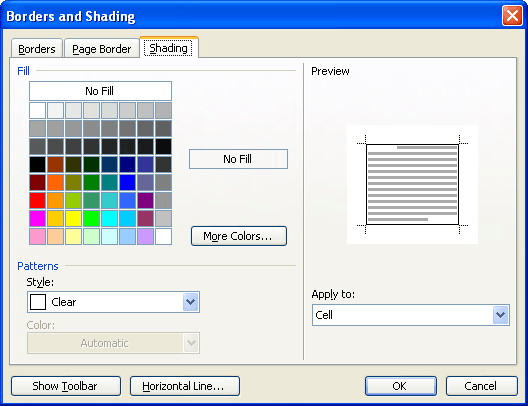Please Note: This article is written for users of the following Microsoft Word versions: 97, 2000, 2002, and 2003. If you are using a later version (Word 2007 or later), this tip may not work for you. For a version of this tip written specifically for later versions of Word, click here: Applying Consistent Shading to a Table.
Written by Allen Wyatt (last updated March 5, 2022)
This tip applies to Word 97, 2000, 2002, and 2003
If you need to work with documents from other Word users, you may have a need to change the formatting that is applied to tables within those documents. For instance, you may need all tables to have 10% shading applied. Applying the shading over and over again can be tedious, however.
There are a couple of things you can do to speed up your formatting task. If you don't have many tables to process, then you will appreciate these steps:

Figure 1. The Shading tab of the Borders and Shading dialog box.
If you have many, many tables you want to format, you might want to create a macro to do the shading for you. The following simple macro steps through each table in a document and applies the 10% shading.
Sub TableShading()
For Each aTable In ActiveDocument.Tables
aTable.Shading.Texture = wdTexture10Percent
Next aTable
End Sub
There are other approaches you can take, as well. (Word is nothing, if not flexible.) For instance, you could create a table style that could be applied to your tables, or you could create an AutoFormat for your tables.
Note:
WordTips is your source for cost-effective Microsoft Word training. (Microsoft Word is the most popular word processing software in the world.) This tip (3920) applies to Microsoft Word 97, 2000, 2002, and 2003. You can find a version of this tip for the ribbon interface of Word (Word 2007 and later) here: Applying Consistent Shading to a Table.

Create Custom Apps with VBA! Discover how to extend the capabilities of Office 365 applications with VBA programming. Written in clear terms and understandable language, the book includes systematic tutorials and contains both intermediate and advanced content for experienced VB developers. Designed to be comprehensive, the book addresses not just one Office application, but the entire Office suite. Check out Mastering VBA for Microsoft Office 365 today!
You may spend some time getting the color in a portion of a table just right, only to be faced with the task of copying ...
Discover MoreWhen you insert a table into your document, it uses a standard-weight line around each cell in the table. If you want to ...
Discover MoreNeed to align numbers around their decimal point within a table? It's easy to do by using the three simple steps provided ...
Discover MoreFREE SERVICE: Get tips like this every week in WordTips, a free productivity newsletter. Enter your address and click "Subscribe."
There are currently no comments for this tip. (Be the first to leave your comment—just use the simple form above!)
Got a version of Word that uses the menu interface (Word 97, Word 2000, Word 2002, or Word 2003)? This site is for you! If you use a later version of Word, visit our WordTips site focusing on the ribbon interface.
Visit the WordTips channel on YouTube
FREE SERVICE: Get tips like this every week in WordTips, a free productivity newsletter. Enter your address and click "Subscribe."
Copyright © 2026 Sharon Parq Associates, Inc.
Comments